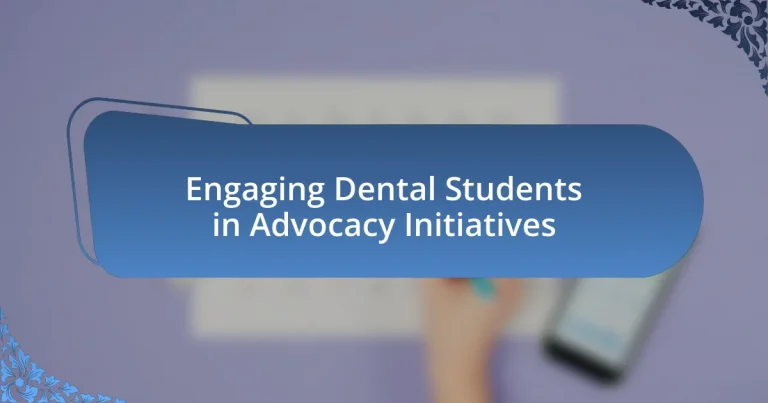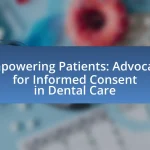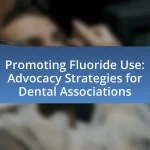Advocacy initiatives in dental education are organized efforts that aim to promote oral health policies, raise public awareness, and influence legislative changes beneficial to dental practice and patient care. Engaging dental students in these initiatives enhances their educational experience, fosters a sense of responsibility towards societal health challenges, and prepares them to become proactive leaders in the dental profession. The article explores the importance of advocacy for dental students, the impact of advocacy on dental practice and patient care, the various types of initiatives students can engage in, and the challenges they face. It also discusses strategies for dental schools to encourage advocacy involvement, the role of mentorship, and best practices for effective advocacy communication.
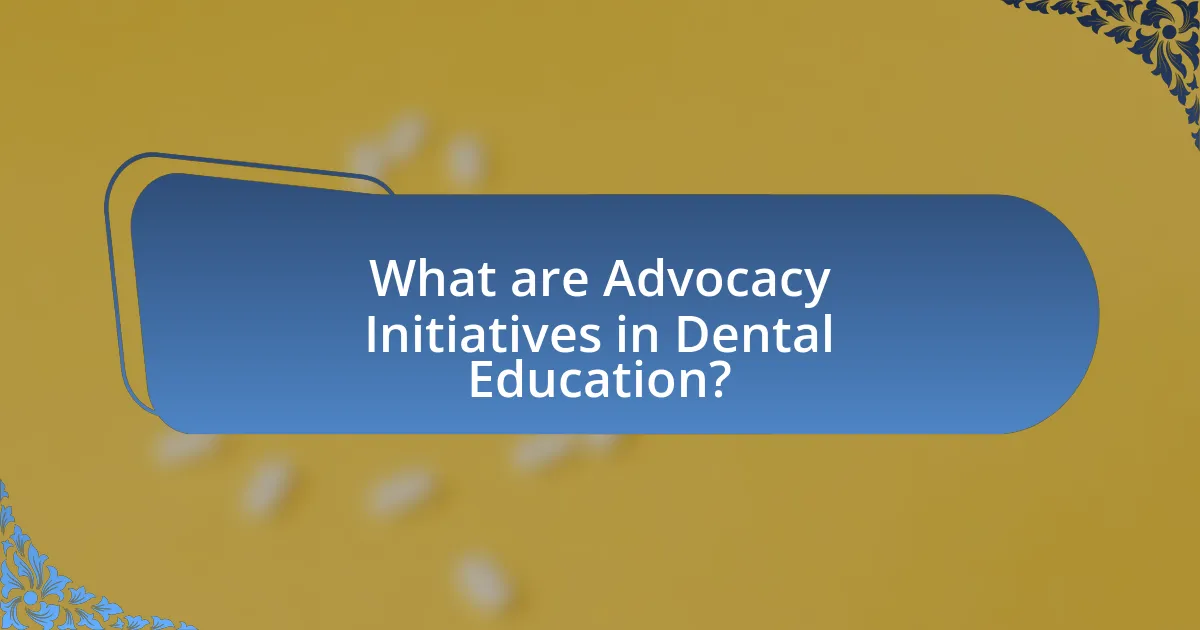
What are Advocacy Initiatives in Dental Education?
Advocacy initiatives in dental education are structured efforts aimed at promoting oral health policies, enhancing public awareness, and influencing legislative changes that benefit dental practice and patient care. These initiatives often involve dental students actively participating in community outreach programs, policy development discussions, and collaborations with professional organizations to address issues such as access to care, health disparities, and preventive measures. Evidence shows that engaging dental students in advocacy not only enriches their educational experience but also fosters a sense of responsibility towards societal health challenges, ultimately preparing them to be proactive leaders in the dental profession.
Why is Advocacy Important for Dental Students?
Advocacy is important for dental students because it empowers them to influence policies that affect oral health care and the profession. Engaging in advocacy helps dental students understand the legislative process, develop leadership skills, and promote public awareness about dental health issues. Research indicates that students who participate in advocacy initiatives are more likely to become active professionals who contribute to the advancement of the dental field and improve patient care outcomes. For instance, the American Dental Association emphasizes that advocacy involvement enhances students’ understanding of the impact of legislation on dental practice and public health.
How does advocacy influence dental practice and patient care?
Advocacy significantly influences dental practice and patient care by promoting policies that enhance access to oral health services and improve patient outcomes. For instance, advocacy efforts can lead to legislative changes that expand Medicaid coverage for dental services, thereby increasing the number of patients who can receive necessary care. Research indicates that states with active dental advocacy organizations report higher rates of preventive dental visits among low-income populations, demonstrating a direct correlation between advocacy and improved patient care access. Furthermore, advocacy initiatives often educate dental professionals about best practices and emerging public health issues, ensuring that patient care is informed by the latest evidence and standards.
What role do dental students play in advocacy efforts?
Dental students play a crucial role in advocacy efforts by actively participating in initiatives that promote oral health awareness and policy changes. They engage in community outreach programs, educate the public about dental health, and collaborate with professional organizations to influence health policies. For instance, dental students often join organizations like the American Student Dental Association, which empowers them to advocate for access to care and preventive services. Their involvement not only enhances their understanding of public health issues but also contributes to shaping policies that impact dental care delivery.
What Types of Advocacy Initiatives Can Dental Students Engage In?
Dental students can engage in various advocacy initiatives, including oral health education programs, community service projects, policy advocacy, and public health campaigns. These initiatives allow dental students to promote awareness about oral health issues, provide preventive care, and influence health policy decisions. For instance, participating in community outreach programs can help dental students educate underserved populations about dental hygiene and access to care, while involvement in policy advocacy can lead to changes in legislation that improve dental health access.
What are the key areas of focus for dental advocacy?
The key areas of focus for dental advocacy include access to care, oral health education, public policy, and workforce issues. Access to care emphasizes the need for equitable dental services, particularly for underserved populations, as studies show that millions lack adequate dental coverage. Oral health education aims to raise awareness about the importance of oral hygiene and preventive care, which is crucial since poor oral health can lead to systemic health issues. Public policy advocacy involves influencing legislation that affects dental practice and funding for oral health programs, as evidenced by initiatives that have successfully expanded Medicaid dental benefits in several states. Workforce issues address the need for a sufficient number of dental professionals to meet community needs, supported by data indicating a projected shortage of dentists in the coming years.
How can dental students participate in community outreach programs?
Dental students can participate in community outreach programs by volunteering for free dental clinics, organizing oral health education workshops, and collaborating with local health organizations. These activities allow dental students to apply their skills in real-world settings while promoting oral health awareness. For instance, many dental schools have partnerships with community health centers that provide opportunities for students to deliver care to underserved populations, enhancing both their clinical experience and community impact.
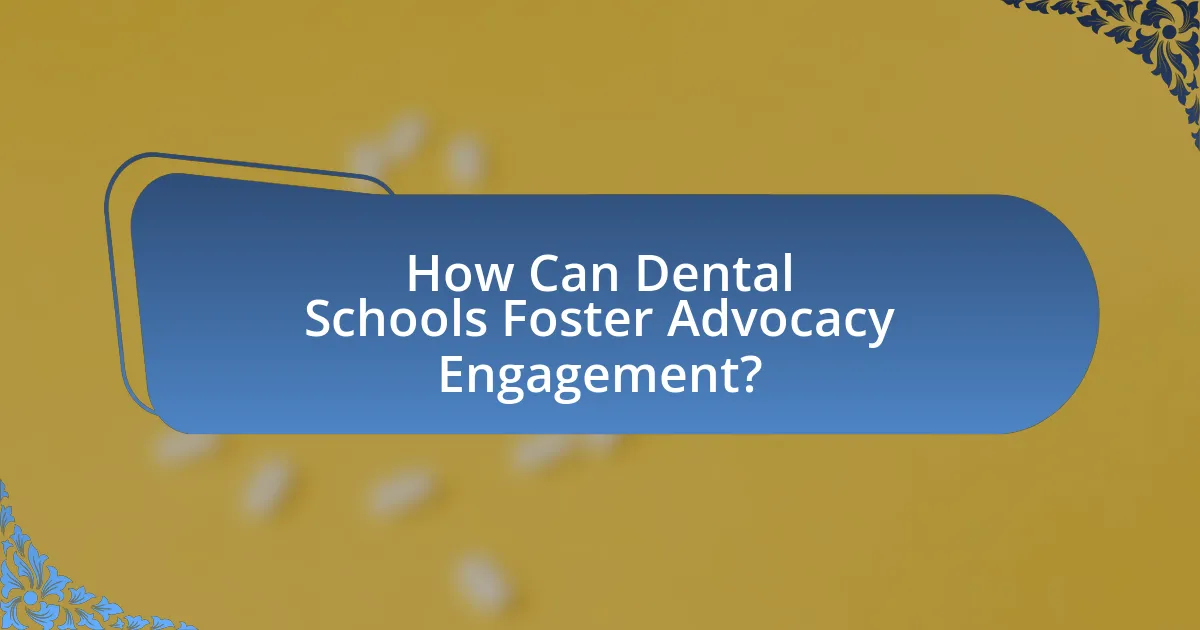
How Can Dental Schools Foster Advocacy Engagement?
Dental schools can foster advocacy engagement by integrating advocacy training into their curricula and providing students with opportunities to participate in community outreach programs. This approach equips students with the necessary skills and knowledge to advocate for oral health issues effectively. For instance, programs like the American Dental Association’s “Give Kids A Smile” initiative allow dental students to engage directly with underserved populations, enhancing their understanding of public health challenges and the importance of advocacy. Additionally, incorporating service-learning projects into the educational framework has been shown to increase students’ commitment to advocacy, as evidenced by research published in the Journal of Dental Education, which highlights the positive impact of experiential learning on students’ advocacy involvement.
What Strategies Can Schools Implement to Encourage Student Involvement?
Schools can implement strategies such as creating student-led organizations, offering mentorship programs, and integrating advocacy into the curriculum to encourage student involvement. Student-led organizations empower individuals to take initiative and develop leadership skills, fostering a sense of ownership in advocacy initiatives. Mentorship programs connect students with experienced professionals, providing guidance and support that enhances engagement. Additionally, integrating advocacy topics into the curriculum ensures that students understand the importance of their involvement and equips them with the necessary knowledge and skills to participate effectively. Research shows that active participation in advocacy initiatives leads to improved student outcomes and a stronger commitment to community service.
How can mentorship programs enhance advocacy participation?
Mentorship programs enhance advocacy participation by providing guidance, support, and networking opportunities for individuals, particularly dental students. These programs connect less experienced advocates with seasoned professionals who can share insights on effective advocacy strategies, thereby increasing the confidence and skills of participants. Research indicates that mentorship can lead to higher levels of engagement; for instance, a study published in the Journal of Dental Education found that students involved in mentorship programs reported a 30% increase in their participation in advocacy activities compared to those without mentorship. This structured support fosters a sense of belonging and encourages proactive involvement in advocacy initiatives, ultimately leading to more effective representation of dental issues.
What resources should be provided to support advocacy initiatives?
To support advocacy initiatives, essential resources include training programs, informational materials, and access to mentorship. Training programs equip participants with skills in public speaking, policy analysis, and grassroots organizing, which are crucial for effective advocacy. Informational materials, such as fact sheets and research reports, provide evidence-based data that advocates can use to support their positions. Access to mentorship from experienced advocates offers guidance and networking opportunities, enhancing the effectiveness of advocacy efforts. These resources collectively empower individuals to engage meaningfully in advocacy initiatives, particularly in the context of dental health issues.
How Can Collaboration with Professional Organizations Benefit Students?
Collaboration with professional organizations benefits students by providing access to resources, networking opportunities, and real-world experiences that enhance their education and career prospects. For instance, dental students who engage with organizations such as the American Dental Association gain insights into industry standards, best practices, and advocacy efforts that shape their future profession. Research indicates that students involved in such collaborations often report higher levels of confidence and preparedness for their careers, as they can participate in workshops, mentorship programs, and internships facilitated by these organizations. This direct involvement not only enriches their academic experience but also fosters essential skills and connections that are crucial for success in the dental field.
What opportunities do professional organizations offer for advocacy training?
Professional organizations offer various opportunities for advocacy training, including workshops, seminars, and mentorship programs specifically designed for dental students. These training sessions often focus on developing skills in public speaking, policy analysis, and grassroots mobilization, which are essential for effective advocacy in the dental field. For example, the American Dental Association provides resources and training events that equip students with the knowledge to engage in legislative processes and advocate for oral health issues. Additionally, organizations may facilitate networking opportunities with experienced advocates, allowing students to learn from real-world experiences and gain insights into successful advocacy strategies.
How can partnerships enhance the impact of advocacy initiatives?
Partnerships can enhance the impact of advocacy initiatives by leveraging diverse resources, expertise, and networks. When organizations collaborate, they can combine their strengths, such as funding, knowledge, and outreach capabilities, which amplifies their collective voice and effectiveness. For instance, a partnership between dental schools and public health organizations can lead to more comprehensive advocacy efforts that address oral health disparities, as evidenced by the successful initiatives in various communities that resulted in increased access to dental care and improved health outcomes. This collaborative approach not only broadens the reach of advocacy messages but also fosters innovation through shared ideas and strategies.
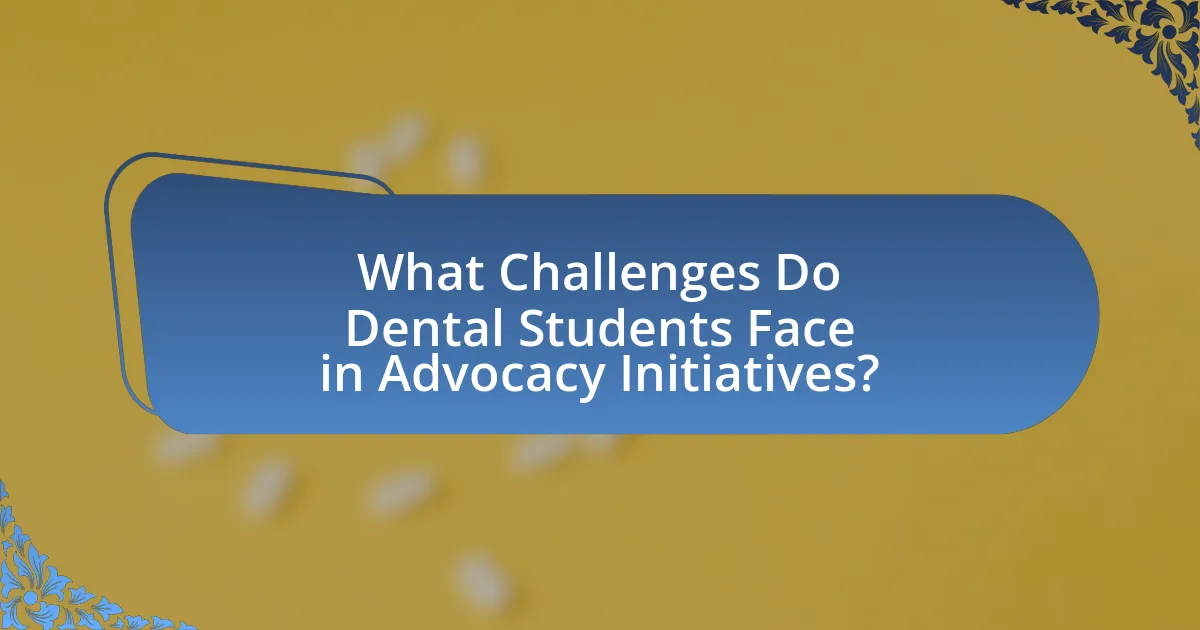
What Challenges Do Dental Students Face in Advocacy Initiatives?
Dental students face several challenges in advocacy initiatives, including time constraints, lack of experience, and limited institutional support. Time constraints arise from the demanding nature of dental education, which often leaves little room for extracurricular activities like advocacy. Additionally, many dental students lack experience in advocacy, making it difficult for them to navigate complex healthcare policies and effectively communicate their positions. Limited institutional support can further hinder their efforts, as schools may not prioritize advocacy training or provide resources for student-led initiatives. These challenges collectively impede dental students’ ability to engage meaningfully in advocacy efforts.
What Barriers Prevent Dental Students from Engaging in Advocacy?
Barriers that prevent dental students from engaging in advocacy include time constraints, lack of awareness, and insufficient support from educational institutions. Time constraints arise from the demanding nature of dental programs, which often leaves students with little opportunity to participate in advocacy activities. Lack of awareness about advocacy issues and opportunities can hinder students from getting involved, as they may not be informed about the importance of advocacy in the dental field. Additionally, insufficient support from educational institutions, such as limited resources or mentorship programs, can further discourage students from pursuing advocacy initiatives. These factors collectively contribute to a lower level of engagement among dental students in advocacy efforts.
How can time management issues affect student participation?
Time management issues can significantly hinder student participation by causing students to miss deadlines and reduce their engagement in activities. When students struggle to allocate their time effectively, they may prioritize academic responsibilities over extracurricular involvement, leading to decreased participation in advocacy initiatives. Research indicates that students with poor time management skills often experience higher stress levels, which can further diminish their motivation to engage in collaborative efforts, such as advocacy. A study published in the Journal of Educational Psychology found that effective time management is correlated with higher academic performance and increased involvement in school activities, highlighting the importance of these skills in fostering student participation.
What misconceptions about advocacy might deter student involvement?
Misconceptions about advocacy that might deter student involvement include the belief that advocacy is only for professionals or experts, the idea that it requires significant time and resources, and the notion that it is ineffective or irrelevant to their field. Many students think that advocacy is reserved for those with extensive experience or formal training, which can discourage them from participating. Additionally, the perception that advocacy demands a large commitment of time and financial resources can lead students to feel overwhelmed and disengaged. Lastly, some students may believe that their efforts in advocacy will not lead to meaningful change, which undermines their motivation to get involved. These misconceptions can significantly limit student engagement in advocacy initiatives within the dental field.
How Can Students Overcome These Challenges?
Students can overcome challenges in engaging with advocacy initiatives by actively participating in structured programs that provide mentorship and resources. These programs often include workshops, networking opportunities, and access to experienced advocates, which equip students with the necessary skills and knowledge to navigate advocacy effectively. Research indicates that students who engage in mentorship programs report a 30% increase in confidence regarding their advocacy abilities, as highlighted in the study “The Impact of Mentorship on Student Advocacy” published in the Journal of Dental Education. This structured support helps students to build connections, understand the advocacy landscape, and develop their voices in the dental community.
What strategies can students employ to balance advocacy with academic responsibilities?
Students can balance advocacy with academic responsibilities by prioritizing time management and setting clear goals. Effective time management allows students to allocate specific hours for advocacy activities while ensuring that academic commitments are met. For instance, creating a weekly schedule that includes dedicated time slots for studying, attending classes, and participating in advocacy initiatives can enhance productivity. Additionally, setting clear, achievable goals for both academic and advocacy efforts helps students maintain focus and motivation. Research indicates that students who engage in structured planning are more likely to succeed in both areas, as they can track their progress and adjust their commitments as needed.
How can peer support networks facilitate advocacy engagement?
Peer support networks can facilitate advocacy engagement by providing a platform for dental students to share experiences, resources, and strategies related to advocacy initiatives. These networks foster a sense of community and belonging, which encourages students to participate actively in advocacy efforts. Research indicates that peer support enhances motivation and confidence, leading to increased involvement in advocacy activities. For instance, a study published in the Journal of Dental Education found that students who engaged in peer-led initiatives reported higher levels of advocacy participation and a greater understanding of the importance of advocacy in their professional development.
What Best Practices Should Dental Students Follow in Advocacy Initiatives?
Dental students should engage in advocacy initiatives by actively participating in community outreach programs, collaborating with professional organizations, and staying informed about public health policies. Active participation allows dental students to understand community needs and promote oral health awareness effectively. Collaborating with organizations such as the American Dental Association provides networking opportunities and resources for impactful advocacy. Staying informed about public health policies ensures that dental students can advocate for relevant changes and contribute to discussions on healthcare access and equity. These practices are supported by studies indicating that student involvement in advocacy enhances their professional development and community impact.
How can students effectively communicate their advocacy messages?
Students can effectively communicate their advocacy messages by utilizing clear, concise language and engaging storytelling techniques. Research indicates that messages framed in personal narratives resonate more with audiences, making them more likely to engage with the content. For example, a study published in the Journal of Health Communication found that personal stories significantly increase the likelihood of message retention and emotional connection, which are crucial for advocacy efforts. Additionally, employing social media platforms allows students to reach a broader audience, as statistics show that 72% of the public uses social media to connect with one another, share information, and engage with issues they care about. By combining personal narratives with strategic use of social media, students can enhance the effectiveness of their advocacy communications.
What are the key elements of a successful advocacy campaign?
The key elements of a successful advocacy campaign include a clear goal, a well-defined target audience, strategic messaging, effective communication channels, and strong coalition-building. A clear goal provides direction and focus, ensuring that all efforts are aligned towards a specific outcome, such as policy change or increased awareness. Identifying a well-defined target audience allows advocates to tailor their messages and strategies to resonate with those who have the power to influence change. Strategic messaging is crucial; it should be compelling, concise, and relevant to the audience’s interests and values. Effective communication channels, such as social media, community events, and traditional media, facilitate the dissemination of messages and engagement with the audience. Finally, strong coalition-building fosters collaboration among diverse stakeholders, enhancing the campaign’s credibility and reach. Research shows that campaigns with these elements are more likely to achieve their objectives, as evidenced by successful initiatives like the American Dental Association’s advocacy efforts, which effectively mobilized dental professionals to influence public policy.
